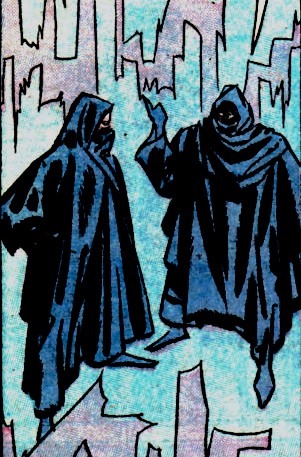
FATES
Membership:
None identified
Purpose:
Caretakers for mortal fate
Affiliations: Tom
Baker, Hiram
Cragmoor, Daniel Doone, Mike
Mathews, Willie Sloan, Death, Eternity and other
Cosmic Entities (see comments)
Enemies:
Larry Adams, Charles Bennett, Charlie Burke, Jim Carson, Archie Craig,
Glenn Dague, Jack Flanders, Sy Flanders, Duke Charles Laure
Hagues, Irene (last name unrevealed), Walter
Krugg, Champ Maggio, Nick Nolan, Sandy Rells, John Tate,
Wilbur Underhill, William Vane, Tony White, others
Base of Operations:
Unidentified "Shadowy" Dimension,
mobile throughout the Universe
First Appearance:
Official True Crime Cases#25/1 (Winter, 1947)
Powers/Abilities:
The Fates are cosmic entities and have lived for over 6 billion
years. They are able to harness cosmic energy for a variety of
effects which are as of yet undefined. They have been shown to be
able to teleport over vast distances instantaneously within the
universe or to other dimensions, become invisible, use mental
telepathy and control and rearrange matter. They have been tasked
with attending to and controlling the fates of mortal beings in the
universe and have the ability to peer through time or even travel
into other eras. They seem to have the ability to grant superhuman
powers to mortals and have them act as their agents. They own the Book of Fate.
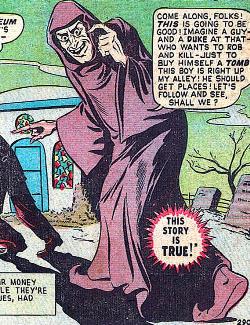
History:
(Tales to Astonish I#33/3 (fb) -
BTS) - Cosmic entities were charged with the task of governing life and
meting out fate. They had been actively controlling the destiny of all
life for 6 billion years, including humanity, which had been under
their jurisdiction for about 2
million years.
(Justice Comics#5/3) – Fate told
the story of Duke Charles Laure Hagues, a member of royalty living in
Budapest, Hungary circa 1850. Obsessed with having a grand monument
built in his name when he died, Duke Hagues, whose wealth and title
were via his marriage to Mathilda and was quite modest, began murdering
local women and stealing their priceless jewels to pay for it. The
local papers dubbed him the anonymous killer "Tiger Man." Meeting a
beautiful young
singer during a party sponsored by his philanthropic wife, Duke Charles
bequeathed her with a stolen pearl necklace as a gift, but was caught
doing
so by Mathilda. His wife threatened to cut him out of her will leaving
Duke Charles a pauper. Feeling disgraced in front of all his friends,
the Duke murdered Mathilda and when the police arrived he blamed the
Tiger Man of the crime and was questioned by inspector Allard, who
deduced he was lying and that he was in fact the Tiger Man and
arrested him. Tried and convicted of his crimes, Duke Charles Hagues
was sentenced to hang and died January 16, 1851. He never got his
monument and was buried in a cheap pine coffin in an
unmarked grave.
(All True Crime Cases#29/2) - Fate
introduced the story of Charles Bennett who, around 1900, was a
small-time gambler in a midwestern town who lived with
his younger brother, Paul, who always got him out of trouble with
angry,
swindled cowboys and townsfolk. No longer wanting to be his brother's
keeper, Paul kicked him out and vowed not to aid him financially.
Charles held
bitter resentment and anger toward Paul, having been banned
from all gambling houses and being financially strapped. so he framed
his
brother for murder. Paul, an innocent man, served 15 years in prison
and
upon release bought a small chemical company that produced medical
drugs and soon became wealthy. Twenty-five years later and down on his
luck, Charles Bennett begged his brother for a job and put him charge
of
his chemical plant while he went overseas on a vacation. Wanting to get
rich fast, Charles, not caring if a new medicine called Liftol (a
heart medication) was safe, had it manufactured, not caring that it
was untested or approved for sale by the
Medical Association. People who bought the drug
died and their deaths implicated Paul Bennett, who went to prison.
Eventually the police with both Paul's assistance and with the prodding
and investigation from his wife, orchestrated a sting to catch Charles.
Armed with a gun, Paul coerced a confession from Charles. When
the police burst in, Charles took his own life, knowing that he would
be
sentenced to death for his crimes anyway.
(Official All True Crime
Cases#26/1) – Fate, who was in control of destinies, influenced the
life and death of Wilbur Underhill in the 1920s whose obsession with
guns led him into a life of crime and murder, and would later become
known as the Tri-State of Terror. His favorite weapon of choice, a
luger he called "Sweetheart", became his downfall when it jammed and
backfired on him while he was eluding capture by the police after he
escaped prison. Underhill was wounded and unable to shoot back, and the
police riddled his
body with bullets as he crawled onto a nearby bed. Fate went on to say
that "Like all those who pit themselves against society, Wilbur
Underhill's end was a bad one...The end for all criminals is
bad....Because crime cannot win!"
(Law Breakers Always Lose#4/6) –
Fate told the story of what happened when hoodlums tried to gamble with
fate. In Seattle dated 1935, Sy and Jack Flanders and Tony White joined
a local racket led by long-time friend Rip Daniels in stealing illegal
slot machines and their money from local bars and night clubs, then
resold them back to local mobsters. During one such heist,
Sy Flanders killed a cop and soon the police were in pursuit. Upon
capture, Sy was sentenced to the gallows for murder while his brother
Jack
and Tony White were sentenced to life imprisonment.
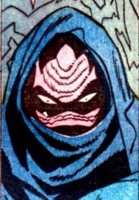 (Tales to Astonish I#33/3) - In
1945, in a
place beyond what we call reality, two Fates discussed the
folly of humankind, which believed it was in control of its destiny and
continued to defy them. One of the Fates wagered a thousand
thunderbolts with the other that he could chose a human at random and
convince him that he could not escape the destiny they had ordained
for him. The other fate, believing humans were aware of their "fate,"
agreed. The Fate appeared before Walter
Krugg, who had just
stolen a valuable necklace and was planning to flee the country. The
Fate confronted Krugg and explained to him that it was futile for
him to run since he could not escape what the Fates had planned, and
no matter where Krugg hid, he would still pay for his crime. But paying
no heed to the mysterious being's cryptic words, Krugg
departed and fled the country. Returning to his shadowy realm,
the Fate reported to his fellow entity that he had lost the wager,
but assured him that although Krugg was now in another country and
possessed the stolen necklace, he wouldn't escape his destiny for
long. Krugg fled to Hiroshima Japan. Not long after, on August
6th 1945, the American military dropped an atomic bomb on
the city.
(Tales to Astonish I#33/3) - In
1945, in a
place beyond what we call reality, two Fates discussed the
folly of humankind, which believed it was in control of its destiny and
continued to defy them. One of the Fates wagered a thousand
thunderbolts with the other that he could chose a human at random and
convince him that he could not escape the destiny they had ordained
for him. The other fate, believing humans were aware of their "fate,"
agreed. The Fate appeared before Walter
Krugg, who had just
stolen a valuable necklace and was planning to flee the country. The
Fate confronted Krugg and explained to him that it was futile for
him to run since he could not escape what the Fates had planned, and
no matter where Krugg hid, he would still pay for his crime. But paying
no heed to the mysterious being's cryptic words, Krugg
departed and fled the country. Returning to his shadowy realm,
the Fate reported to his fellow entity that he had lost the wager,
but assured him that although Krugg was now in another country and
possessed the stolen necklace, he wouldn't escape his destiny for
long. Krugg fled to Hiroshima Japan. Not long after, on August
6th 1945, the American military dropped an atomic bomb on
the city.
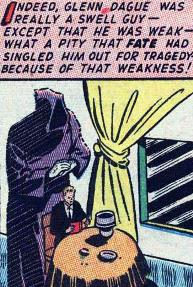 (Official
True Crime Cases#25/1) -
A being claiming to be Fate targeted a weak-willed young man called
Glenn Dague into being an unwilling participant in a murderous crime
spree perpetrated by a young woman named Irene that spread across
multiple states. As he was too weak and afraid, Irene would kill him if
he
fled, so he blindly followed her until they were both eventually caught
along the Texas/Mexico border. Both he and Irene were later tried
and convicted, and sentenced to death by electrocution.
(Official
True Crime Cases#25/1) -
A being claiming to be Fate targeted a weak-willed young man called
Glenn Dague into being an unwilling participant in a murderous crime
spree perpetrated by a young woman named Irene that spread across
multiple states. As he was too weak and afraid, Irene would kill him if
he
fled, so he blindly followed her until they were both eventually caught
along the Texas/Mexico border. Both he and Irene were later tried
and convicted, and sentenced to death by electrocution.
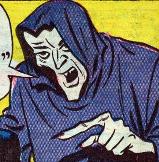 (Law Breakers
Always Lose#3/2) -
Fate told the tale of John Tate, who felt pressured to provide
financial stability and a better way of life for his wife and infant
son. Turning to crime he joined a gang and robbed
Tillman's Jewelry store, then returned home to hide his cut. When his
wife found out about where he was getting his money, she convinced him
to quit the gang and turn himself in because his son would not grow up
being proud of him. Doing the right thing, John Tate later turned
state's
evidence against his old gang but also ended up serving five years in
prison for his crime.
(Law Breakers
Always Lose#3/2) -
Fate told the tale of John Tate, who felt pressured to provide
financial stability and a better way of life for his wife and infant
son. Turning to crime he joined a gang and robbed
Tillman's Jewelry store, then returned home to hide his cut. When his
wife found out about where he was getting his money, she convinced him
to quit the gang and turn himself in because his son would not grow up
being proud of him. Doing the right thing, John Tate later turned
state's
evidence against his old gang but also ended up serving five years in
prison for his crime.
(Justice Comics#4/3) - Fate
influenced the destinies of three criminals. Amused, Fate witnessed
small-time crook Sandy Rells break into a posh apartment in Chicago's
fashionable Northside and open a safe containing thousands of dollars
in heroin belonging to two drug kingpins called Harry Marsden and
Fettering. When Marsden and Fettering entered the room unexpectedly,
Rells hid under a bed. Marsden saw that the drugs were missing
and assumed his partner was trying to double cross him and so shot
Fettering,
killing him and and wounding a hidden Rells in the arm as the bullet
passed through the dead Fettering's body. Eventually both Rells and
Marsden were caught by the FBI with Rells serving five years in prison
for drug possession and Marsden sentenced to life on Alcatraz.
(Justice Comics#6/1) - Fate told
the story of a real "wise guy" named Jim Carson whose crimes and
carefree show-off attitude sealed his fate. Jim Carson was born into a
wealthy family and all through his college years threw money around to
make himself look important. Notorious as a tipper and big spender, he
often treated his friends and others to rounds of drinks at local night
clubs, making people wonder where he got all his money from. Years
later
and now employed in a bank, his flashy attitudes about money got him
fired and he turned to crime as the head of a small gang of
criminals. Eventually Carson was captured by the police and
imprisoned for 25 years, but soon escaped.
The authorities scoured the surrounding towns and recaptured
Carson due to his over the top attitudes about money and since he stood
out as most of the locals did not have that kind of money, let alone
flaunted it. He was now destined to serve 32 years in the
State Penn.
(Complete Mystery#2/1) – Fate
introduced the tale of William Vane who was mad with jealousy, his son
Johnny who was in love with Della, the daughter of his worst enemy, and
an innocent
bystander called Pete Jensen, who was a tramp who looked like
William Vane. Fate explained that these
are elements from which tragedy is made. Wanting to kill his
rival
Daniel Doone who flaunted his wealth in their childhood while William
Vane grew up poor, William Vane hired a dreg of society to murder him.
Fate
watched this tale unfold, stepped into the picture and placed a
homeless
man named Pete Jensen, a tramp whose face was an identical match to
William Vane. Setting Jensen in front of a speeding car driven
by Vane, and making it look like an accident, William Vane
stopped his
car and to his amazement, discovered the tramp looked like him.
Hatching an idea, William Vane hired the tramp for a thousand
dollars to attend a business
meeting to act as his alibi while he set out to murder his
rival. William Vane kidnaped Daniel Doone at gunpoint and both drive
off to a
cliff overlooking a river at which point Vane forced him to drive off
the cliff. Unknown to both men, Daniel Vane had cut the car's brakes
earlier after having a heated run in with Daniel Doone. With his alibi
intact, William Vane was acquitted of murder while his son, after a
lengthy
investigation by police, was found guilty although Daniel Doone's body
was never found. Desperate to find the now vanished tramp to clear his
son of any crime and avoid the death penalty, William Vane was unable
to locate
the man and later committed suicide, but his body could not be
identified. Fate
stepped in; Daniel Doone had survived the horrific crash and
drifted down river with amnesia for a few years. William Vane's son
married
Doone's daughter and both lived happily ever after.
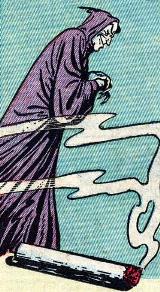 (Crime
Can't Win#43) -
Fate influenced the destiny of a gang of criminals lead by Champ Maggio
who were arrested and tried for robbing the safe at the Elite Insurance
company. For years the gang had escaped prosecution for similar crimes,
but using modern forensic techniques all were convicted by three pieces
of evidence: a gun, a brown tweed suit owned by Champ Maggio, and a
stamped-out cigarette.
(Crime
Can't Win#43) -
Fate influenced the destiny of a gang of criminals lead by Champ Maggio
who were arrested and tried for robbing the safe at the Elite Insurance
company. For years the gang had escaped prosecution for similar crimes,
but using modern forensic techniques all were convicted by three pieces
of evidence: a gun, a brown tweed suit owned by Champ Maggio, and a
stamped-out cigarette.
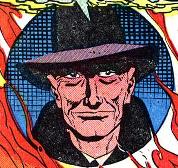 (Marvel
Tales I#101/1) - Fate
overheard a discussion between Larry Adams and his friend Willie
Grant, who said that there was no way to escape fate. Larry
Adams
replied that it was all a bunch of bunk and that a grown man
determined his own
life and not from a book written on the day they were born. Amused by
Larry Adam's belief , Fate disguised as a human dressed in
black
interrupted their conversation and said to Larry that he was "stubborn
and that fate—fate...no one can outwit the writing of destiny", and
mysteriously vanished. Everywhere Larry went, Fate seemed to follow him
at a distance unnerving him and leaving etched signs "Fate" as a
reminder before vanishing. Days later Larry was given a business task
by his boss to travel to Chicago. The
next day while on board the plane, Fate reappeared, this time in the
seat next to
Larry; that very minute the plane's motor caught on fire and the
plane began to crash. Fearing his death, Fate said to Larry that he
would
give him another chance to live; time was reversed and his
day rewritten. Larry awoke from bed believing he had a dream
but
decided
instead of going to Chicago by plane, he would make the trip
by
car. But Fate had other plans-----Fate caused the plane he was
scheduled to be on to crash--into his car! In the hospital, a dying
Larry spoke his last words to his friend Willie Grant that he was was
right and mumbled the words "...Fate...Fate." Fate next appeared at
Larry's grave and said that there was no escape and your destiny was
written in the Book of Life and Death the day you were born and that he
knows...he wrote it!
(Marvel
Tales I#101/1) - Fate
overheard a discussion between Larry Adams and his friend Willie
Grant, who said that there was no way to escape fate. Larry
Adams
replied that it was all a bunch of bunk and that a grown man
determined his own
life and not from a book written on the day they were born. Amused by
Larry Adam's belief , Fate disguised as a human dressed in
black
interrupted their conversation and said to Larry that he was "stubborn
and that fate—fate...no one can outwit the writing of destiny", and
mysteriously vanished. Everywhere Larry went, Fate seemed to follow him
at a distance unnerving him and leaving etched signs "Fate" as a
reminder before vanishing. Days later Larry was given a business task
by his boss to travel to Chicago. The
next day while on board the plane, Fate reappeared, this time in the
seat next to
Larry; that very minute the plane's motor caught on fire and the
plane began to crash. Fearing his death, Fate said to Larry that he
would
give him another chance to live; time was reversed and his
day rewritten. Larry awoke from bed believing he had a dream
but
decided
instead of going to Chicago by plane, he would make the trip
by
car. But Fate had other plans-----Fate caused the plane he was
scheduled to be on to crash--into his car! In the hospital, a dying
Larry spoke his last words to his friend Willie Grant that he was was
right and mumbled the words "...Fate...Fate." Fate next appeared at
Larry's grave and said that there was no escape and your destiny was
written in the Book of Life and Death the day you were born and that he
knows...he wrote it!
(Uncanny Tales I#36/1) - Fate
played a cruel trick on a criminal named Nick Nolan serving life in
prison who wanted to escape. Fate placed a newspaper article in the
morning paper describing an anonymous inventor who invented a strange
electronic teleporter that claimed to work and needed a human to test
it. Since his lab's address was listed in the article and it was
nearby, Nolan made a break and escaped while working on the
prison road
gang the next morning. Making his way to the lab Nolan,
desperate
to use the scientist's device to escape, was given the device, a vest
with dials and destinations listed, and shown how to use it. Activating
the electronic teleporter, Nolan
disappeared and reappeared in Africa in front of two savage lions.
Sensing
that it was too dangerous to be there, he activated the teleport device
set
for London and reappeared in a python cage in the London Zoo and again
in Paris falling from the top of the Eiffel Tower and yet again on a
raging Saint Lawrence river flowing over Niagara Falls. Escaping once
again by using the teleport device, Nolan's final destination
was
his previous jail cell. Feeling anger and confusion, Nolan was left
wondering who the inventor really was. A smiling inventor was then seen
with the closing words---"his name? Some men call him Fate!"
(Strange Tales of the Unusual#9/3)
- Fate (or a being resembling Father Time) went on to weave a tale that
every man's fate is written in the Book of Destiny and that fate can
not be altered. One story was that of Tom
Baker, a gardener who bought an unfamiliar can of insecticide
called Shur-Kil as he had been told it was cheaper and would
work just a well, but was actually explosive. Back on his
farm, Baker tried to open the dangerous can using a
hammer, can opener, jack-hammer and even a steam roller to unseal it
but these attempts all failed. In anger, Baker threw the can away and
it exploded violently. Fate, shown with a scythe, revealed that it was
not Tom Baker's time to die and that he ought to know!
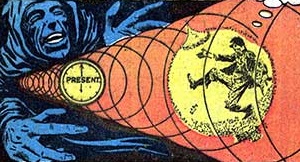
(World of Fantasy#18/2) - In 1959, electrical engineer Frank Hanes felt cheated by the company where he had worked for fifteen years. After stealing some money from the company's safe, Hanes used his time machine to travel a century into the future--Fate was watching him and laughed, for it knew of the coming events. When Hanes arrived in 2059, he found the police waiting to arrest him, so he reactivated the time machine to take him back to the past. But Hanes overshot his starting point and went to 1944 instead; regressed in age by fifteen years, and with no memory of the time machine, Hanes had just been hired by the very same company, but he was contemplating taking a job offer with another company instead--Fate was watching him, and wondered what Hanes would decide.
(Tales
to Astonish I#30/2 - BTS) - The Fates gifted hotel
elevator operator Willie Sloan with power and appointed him as one
of their human operatives. They assigned him to protect others from
being killed before it was their time to die.
(Tales
of Suspense I#33/1 - BTS) - Reclusive millionaire Hiram
Cragmoor was
tasked by Fate to be responsible for guiding the souls of the dead to
their respective afterlives. Spending a lifetime trapped within
a giant ruby, Hiram sat in a chair and was given instructions from
the "Greater Realm" where the souls would be sent when they
ended their mortal phase. Having grown weary with this age-long
task, Hiram changed places with Mike
Mathews, an unscrupulous tabloid
reporter, and chose to pass on to the next plane.
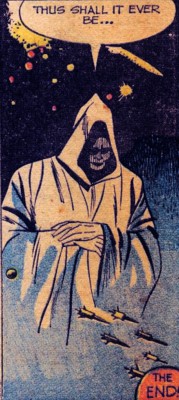
(Tales
of Suspense I#35/4) - A Fate became amused after watching a series of
repeating events unfold over time. He went on to explain that
nothing ever changes and no one is really much different from anyone
else. He presented an account of an alternate future Earth
where robot servants who possessed superior intelligence felt
that humankind viewed them as inferior and showed no respect for them.
They all banded together and fled Earth in rockets to colonize their
own world. Over time, the robots also built a servant race of
their own. These newer "robots" in turn felt misused,
and fled this planet under similar circumstances.
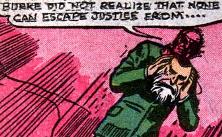 (Strange Tales I#100/1) - An
unscrupulous man called Charlie Burke owned an operated a
failing amusement park attraction called "The Mad Maze". Burke had
created an unbeatable maze and drew in crowds of people with the reward
of $10,000 if anyone could escape by finding the exit. Unknown to
anyone else, Charlie Burke's "Mad Maze" had no exit. Threatened to be
exposed as a con-man by a reporter for The Daily Express
after the park had closed for the day, Burke lured the man into his
maze and sealed the door shut and turned off the air vents. The
reporter died of asphyxiation and the police the next day did not feel
the reporter died by foul play, but rather by an unfortunate accident.
Later when a new maze in the amusement park opened and began drawing
his customers away, Charlie approached his new rival with a business
proposition of becoming partners. The new maze operator declined his
offer and told Charlie Burke he would pack up and leave if he could
solve his maze. Accepting the challenge Charlie entered but soon
discovered to his horror, he became trapped in unbeatable maze with
death traps and other pitfalls. The new maze operator revealed himself,
removing his mask to reveal his true identity and explained that
Charlie would eventually make it out of his maze, but the exit only led
down into a bottomless chasm beneath the earth (possibly Hell) and
stated that none could escape justice from "a man called Fate".
(Strange Tales I#100/1) - An
unscrupulous man called Charlie Burke owned an operated a
failing amusement park attraction called "The Mad Maze". Burke had
created an unbeatable maze and drew in crowds of people with the reward
of $10,000 if anyone could escape by finding the exit. Unknown to
anyone else, Charlie Burke's "Mad Maze" had no exit. Threatened to be
exposed as a con-man by a reporter for The Daily Express
after the park had closed for the day, Burke lured the man into his
maze and sealed the door shut and turned off the air vents. The
reporter died of asphyxiation and the police the next day did not feel
the reporter died by foul play, but rather by an unfortunate accident.
Later when a new maze in the amusement park opened and began drawing
his customers away, Charlie approached his new rival with a business
proposition of becoming partners. The new maze operator declined his
offer and told Charlie Burke he would pack up and leave if he could
solve his maze. Accepting the challenge Charlie entered but soon
discovered to his horror, he became trapped in unbeatable maze with
death traps and other pitfalls. The new maze operator revealed himself,
removing his mask to reveal his true identity and explained that
Charlie would eventually make it out of his maze, but the exit only led
down into a bottomless chasm beneath the earth (possibly Hell) and
stated that none could escape justice from "a man called Fate".
(Strange
Tales I#101/3 - BTS) - A being called Fate altered the form of a ticket
for the S.S Palace, a tramp steamer, which was sold to criminal
Archie Craig. Craig sought to escape the police and flee the country,
but the ticket -- on two separate occasions -- transformed into a
piece of paper with only "X-35" printed on it. Thinking the
ticket seller was trying to pull a fast one on him, Craig pulled a
gun and chased the agent outside. Archie Craig was then struck by a
speeding car and killed instantly. The license plate on the car read
"X-35".
(Strange Tales I#105/2) - A Fate
was reading
a great ledger (the Book of Fate) with the names of mortals who tried
to escape their ill-fated destinies. He went on to tell the
tale of one such man who was plagued by recurring nightmares of being
a prisoner in solitary confinement. The man -- thinking he
could escape his fate -- boarded a boat and set sail to a new land
where he would never be placed in prison. The boat sank and as
the sole survivor, he washed up on the shore of an uncharted desert
isle. The man's name: Robinson Crusoe!
Comments:
Created by an uncredited writer, Sol Brodsky (art) and Stan Lee (editor)
Unfortunately, most of this
profile must remain as speculation. The only reason I joined them
together was mainly due to the chronology of these stories and many
unanswered similarities they have with each other. These stories
unless otherwise noted by Marvel writers in the past, present or
future do not belong on Earth-616 but on some other alternate Earth
dimension(s). I don't see why they can't be, after all these
beings are powerful cosmic entities able to manipulate both time and
space and might very well also exist on any and all alternate Earths.
The being called Fate appeared in
various Crime comics published by Atlas and seemed to serve as a foil
or host introducing and even taking an active part in some of these
stories and was similar to the Crypt Keeper from EC comics Tales From
the Crypt series. Fate always seemed to have some sick sense of justice
concerning the destiny planned for the criminals that were featured.
It is unknown if the cosmic
beings called the Fates are related to any of the other metaphysical
entities such as Death or Eternity. It is likely they work alongside
both beings. It also remains unknown what connection these entities
may have with the Fates or the Norns from Greek and Asgardian
mythology. Possibly they could be their offspring or appointed by
them to act as their agents in the distant past when man evolved and
began worshiping gods. Maybe they could be part of their race
altogether.
Just speculation on my part, but
the Fates
from mythology could be empowered operatives by the cosmic Fates that
were later deified. Another theory is that the cosmic Fates are
connected to the Norns/Fates from mythology with different appearances
or they were aspects of them. Chalk it up to artist interpretation.
The demon called the Messenger
served a Hell lord
called the Master Judge of the Lower Depths and was in charge of
ferrying souls to the afterlife to Hades when their names were written
in a ledger called the Fatal Book. His appearance resembles that of the
Fates and may infarct be one of them serving other death gods or
demons.
The Book itself in all aspects is quite similar to the Book of Fate.
These
Fates certainly took an interest in assorted criminals (notably thieves
and killers), watching their moves, at times intervening so that the
criminals would be caught and punished. Evidently they also didn't like
being mocked.
---Grendel Prime
In regards to the red-skinned "man called Fate" (@ Strange Tales I#100/1): About thirty years ago, I remember reading an article in some comics news-magazine (maybe Comics Scene or Comics Feature) that mentioned this story--the "man called Fate" was originally drawn to be the Devil (thus the red skin), but it was changed to get the story approved by the Comics Code.
--Ron Fredricks
Mistress Fate (Young Allies Comics#6 (January, 1943) from the Young Allies' "Comet Of Doom" story could be connected to the Fates.
--Gammatotem
Thanks to Ron Fredricks for adding World of Fantasy#18.
Profile
by AvatarWarlord72.
CLARIFICATIONS:
The Fates have no known connections to
- Captain
Fate (Jebediah Fate), pirate captain, magic user @
Man-Thing I#13
- Ian Fate,
sorcerer, sought revenge on Devil-Slayer who had inadvertently slain
his wife back in his mercenary days @ Marvel Team-Up I#122
- Fateball
(Laura Broadbahr), B-Sides, photographic reflexes, skilled fighter,
uses fateball/"magic eight-ball" to determine the future and the truth
@ B-Sides#1
- Fates
(Klothos/Urd, Atropos/Verdani, Lachesis/Skuld), apparent daughters of
Zeus and Themis @ Journey into Mystery I#102
- or any other "Fate" or
similar
characters
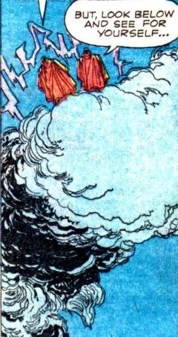
"Shadowy" Dimension
(Tales to
Astonish I#33/3) - The Shadowy dimension is an alien realm located
somewhere beyond reality and the home to the Fates. The dimension
appears to be composed of variable cloud formations that constantly
discharge lightning. This realm appears to constantly alternate
between total darkness to light. Other spherical worlds can be seen
off to the distance. Two Fates standing on a cloud formation were
viewing the Earth and wagered that man could not be convinced
that he was not control his own destiny. Unable to convince Walter
Krugg that he would not be able to escape justice for his crime, the
Fate not conceding defeat, returned to his shadowy realm, confident
that although he had lost the bet, the man would still meet his fate.
--Tales to
Astonish I#33/3
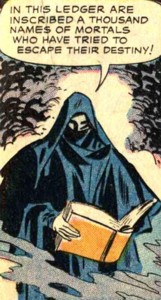
Book of Fate
This book contained thousands of
names of mortals that have sometime in their lives tried to alter
their fate.
In one case, a Fate
read from the Book of Fate and narrated the
story of a man who was plagued by recurring nightmares about being in
a prison and housed in solitary confinement. He then goes on to say
that the man decided to alter his fate by leaving the country by boat
to a place where he could never be placed in prison. The boat later
sank and the man, being the only survivor washed ashore on a desert
island-his name, Robinson Crusoe! It is unknown if this book was
quasi-mystical and possessed any special power or abilities.
It was also called "The Book of
Life and Death" in Marvel Tales I#101/1 and "Book of Destiny"
in
Strange Tales of the Unusual#9/3.
--Marvel Tales I#101/1 (Strange
Tales of the Unusual#9/3, Strange
Tales I#105/2
images:
(without ads)
Tales to Astonish I#33/3, p2, pan2
(2 Fates, main image)
Justice#5/3, p1, pan1 (full body image, turned to reader)
Tales to Astonish I#33/3, p2, pan2 (close up, pink alien face)
Official True Crime Cases#25/1 p3, pan1 (looming behind a chair)
Law Breakers Always Lose#3/2 p1, pan1 (close-up head shot, white
human-like face)
Crime Can't Win#43 p2,pan1 (full body image, with cigarette)
Marvel Tales I#101/1, p1, pan1 (disguised as a man in black clothing)
World of Fantasy#18/2, p4, pan4 (Fate laughs at Frank Hanes)
Tales of Suspense I#35/4, p, pan (unidentified Fate)
Strange Tales I#100, p7, pan5 (Fate. mask removed)
Tales to Astonish I#33/3, p5, pan2 ("Shadowy" dimension)
Strange Tales I#105/2, p2, pan 1 (Book of Fate)
Appearances:
Official True Crime Cases#25/1 (Winter, 1947) - uncredited writer, Sol
Brodsky (art), Stan Lee (editor)
All True Crime Cases#26/1 (February, 1948) - uncredited writer, Syd
Shores (art), uncredited editor
Law Breakers Always Lose#3/2 (August, 1948) - uncredited writer,
artist, editor
Justice Comics#4/3 (August, 1948) - uncredited writer, artist, editor
All True Crime Cases#29/2 (September, 1948) - uncredited writer,
artist, editor
Justice Comics#5/3 (September, 1948) - uncredited writer, artist, editor
Justice Comics#6/1 (October, 1948) - uncredited writer, artist, editor
Law Breakers Always Lose#4/6 (October, 1948) - uncredited writer,
artist, editor
Complete Mystery#2/1 (October, 1948) - Stan Lee (writer), Syd Shores
(art), uncredited editor
Crime Can't Win#43 prose (February, 1951) - uncredited writer, Allen
Bellman (art?), uncredited editor
Marvel Tales I#101/1 (June, 1951) - uncredited writer, Paul Reinman
(art), uncredited editor
Uncanny Tales I#36/1 (October, 1955) - uncredited writer, Bob Powell
(art), uncredited editor
Strange Tales of the Unusual#9/3 (April, 1957) - uncredited writer,
Sol Brodsky (art), Stan
Lee (writer?/editor?)
World of Fantasy#18/2 (June, 1959) - uncredited writer, Steve Ditko (artist), Stan Lee (editor)
Tales to Astonish I#30 (April, 1962) - uncredited writer, Don Heck
(artist), Stan Lee
(editor)
Tales to Astonish I#33 (July, 1962) - uncredited writer, Don Heck
(artist), Stan Lee
(editor)
Tales of Suspense I#33 (September, 1962) - uncredited writer, Jack
Kirby (pencils), Dick
Ayers (inks), Stan Lee (editor)
Strange Tales I#100/1 (September, 1962) - uncredited writer, Jack Kirby
(pencils), Dick Ayers (inks), Stan Lee (editor)
Strange Tales I#101/3 (October, 1962) - Stan Lee (writer/editor), Steve
Ditko (artist)
Tales of Suspense I#35 (November, 1962) - uncredited writer, Paul
Reinman (artist), Stan
Lee (editor)
Strange Tales I#105 (February, 1963) - Stan Lee (plot/editor), Larry
Lieber (script), Don Heck (artist)
First Posted: 12/22/2013
Last updated: 04/15/2018
Any Additions/Corrections? please let me know.
Non-Marvel Copyright info
All other characters mentioned or pictured are ™ and
© 1941-2099 Marvel Characters, Inc. All Rights Reserved.
If you like this stuff, you should check out the real thing!
Please visit The Marvel Official Site at: http://www.marvel.com
Special Thanks to www.g-mart.com for hosting the Appendix, Master List, etc.!
Back to Groups
 (Tales to Astonish I#33/3) - In
1945, in a
place beyond what we call reality, two Fates discussed the
folly of humankind, which believed it was in control of its destiny and
continued to defy them. One of the Fates wagered a thousand
thunderbolts with the other that he could chose a human at random and
convince him that he could not escape the destiny they had ordained
for him. The other fate, believing humans were aware of their "fate,"
agreed. The Fate appeared before Walter
Krugg, who had just
stolen a valuable necklace and was planning to flee the country. The
Fate confronted Krugg and explained to him that it was futile for
him to run since he could not escape what the Fates had planned, and
no matter where Krugg hid, he would still pay for his crime. But paying
no heed to the mysterious being's cryptic words, Krugg
departed and fled the country. Returning to his shadowy realm,
the Fate reported to his fellow entity that he had lost the wager,
but assured him that although Krugg was now in another country and
possessed the stolen necklace, he wouldn't escape his destiny for
long. Krugg fled to Hiroshima Japan. Not long after, on August
6th 1945, the American military dropped an atomic bomb on
the city.
(Tales to Astonish I#33/3) - In
1945, in a
place beyond what we call reality, two Fates discussed the
folly of humankind, which believed it was in control of its destiny and
continued to defy them. One of the Fates wagered a thousand
thunderbolts with the other that he could chose a human at random and
convince him that he could not escape the destiny they had ordained
for him. The other fate, believing humans were aware of their "fate,"
agreed. The Fate appeared before Walter
Krugg, who had just
stolen a valuable necklace and was planning to flee the country. The
Fate confronted Krugg and explained to him that it was futile for
him to run since he could not escape what the Fates had planned, and
no matter where Krugg hid, he would still pay for his crime. But paying
no heed to the mysterious being's cryptic words, Krugg
departed and fled the country. Returning to his shadowy realm,
the Fate reported to his fellow entity that he had lost the wager,
but assured him that although Krugg was now in another country and
possessed the stolen necklace, he wouldn't escape his destiny for
long. Krugg fled to Hiroshima Japan. Not long after, on August
6th 1945, the American military dropped an atomic bomb on
the city.

 (Official
True Crime Cases#25/1) -
A being claiming to be Fate targeted a weak-willed young man called
Glenn Dague into being an unwilling participant in a murderous crime
spree perpetrated by a young woman named Irene that spread across
multiple states. As he was too weak and afraid, Irene would kill him if
he
fled, so he blindly followed her until they were both eventually caught
along the Texas/Mexico border. Both he and Irene were later tried
and convicted, and sentenced to death by electrocution.
(Official
True Crime Cases#25/1) -
A being claiming to be Fate targeted a weak-willed young man called
Glenn Dague into being an unwilling participant in a murderous crime
spree perpetrated by a young woman named Irene that spread across
multiple states. As he was too weak and afraid, Irene would kill him if
he
fled, so he blindly followed her until they were both eventually caught
along the Texas/Mexico border. Both he and Irene were later tried
and convicted, and sentenced to death by electrocution.  (Law Breakers
Always Lose#3/2) -
Fate told the tale of John Tate, who felt pressured to provide
financial stability and a better way of life for his wife and infant
son. Turning to crime he joined a gang and robbed
Tillman's Jewelry store, then returned home to hide his cut. When his
wife found out about where he was getting his money, she convinced him
to quit the gang and turn himself in because his son would not grow up
being proud of him. Doing the right thing, John Tate later turned
state's
evidence against his old gang but also ended up serving five years in
prison for his crime.
(Law Breakers
Always Lose#3/2) -
Fate told the tale of John Tate, who felt pressured to provide
financial stability and a better way of life for his wife and infant
son. Turning to crime he joined a gang and robbed
Tillman's Jewelry store, then returned home to hide his cut. When his
wife found out about where he was getting his money, she convinced him
to quit the gang and turn himself in because his son would not grow up
being proud of him. Doing the right thing, John Tate later turned
state's
evidence against his old gang but also ended up serving five years in
prison for his crime.  (Crime
Can't Win#43) -
Fate influenced the destiny of a gang of criminals lead by Champ Maggio
who were arrested and tried for robbing the safe at the Elite Insurance
company. For years the gang had escaped prosecution for similar crimes,
but using modern forensic techniques all were convicted by three pieces
of evidence: a gun, a brown tweed suit owned by Champ Maggio, and a
stamped-out cigarette.
(Crime
Can't Win#43) -
Fate influenced the destiny of a gang of criminals lead by Champ Maggio
who were arrested and tried for robbing the safe at the Elite Insurance
company. For years the gang had escaped prosecution for similar crimes,
but using modern forensic techniques all were convicted by three pieces
of evidence: a gun, a brown tweed suit owned by Champ Maggio, and a
stamped-out cigarette.  (Marvel
Tales I#101/1) - Fate
overheard a discussion between Larry Adams and his friend Willie
Grant, who said that there was no way to escape fate. Larry
Adams
replied that it was all a bunch of bunk and that a grown man
determined his own
life and not from a book written on the day they were born. Amused by
Larry Adam's belief , Fate disguised as a human dressed in
black
interrupted their conversation and said to Larry that he was "stubborn
and that fate—fate...no one can outwit the writing of destiny", and
mysteriously vanished. Everywhere Larry went, Fate seemed to follow him
at a distance unnerving him and leaving etched signs "Fate" as a
reminder before vanishing. Days later Larry was given a business task
by his boss to travel to Chicago. The
next day while on board the plane, Fate reappeared, this time in the
seat next to
Larry; that very minute the plane's motor caught on fire and the
plane began to crash. Fearing his death, Fate said to Larry that he
would
give him another chance to live; time was reversed and his
day rewritten. Larry awoke from bed believing he had a dream
but
decided
instead of going to Chicago by plane, he would make the trip
by
car. But Fate had other plans-----Fate caused the plane he was
scheduled to be on to crash--into his car! In the hospital, a dying
Larry spoke his last words to his friend Willie Grant that he was was
right and mumbled the words "...Fate...Fate." Fate next appeared at
Larry's grave and said that there was no escape and your destiny was
written in the Book of Life and Death the day you were born and that he
knows...he wrote it!
(Marvel
Tales I#101/1) - Fate
overheard a discussion between Larry Adams and his friend Willie
Grant, who said that there was no way to escape fate. Larry
Adams
replied that it was all a bunch of bunk and that a grown man
determined his own
life and not from a book written on the day they were born. Amused by
Larry Adam's belief , Fate disguised as a human dressed in
black
interrupted their conversation and said to Larry that he was "stubborn
and that fate—fate...no one can outwit the writing of destiny", and
mysteriously vanished. Everywhere Larry went, Fate seemed to follow him
at a distance unnerving him and leaving etched signs "Fate" as a
reminder before vanishing. Days later Larry was given a business task
by his boss to travel to Chicago. The
next day while on board the plane, Fate reappeared, this time in the
seat next to
Larry; that very minute the plane's motor caught on fire and the
plane began to crash. Fearing his death, Fate said to Larry that he
would
give him another chance to live; time was reversed and his
day rewritten. Larry awoke from bed believing he had a dream
but
decided
instead of going to Chicago by plane, he would make the trip
by
car. But Fate had other plans-----Fate caused the plane he was
scheduled to be on to crash--into his car! In the hospital, a dying
Larry spoke his last words to his friend Willie Grant that he was was
right and mumbled the words "...Fate...Fate." Fate next appeared at
Larry's grave and said that there was no escape and your destiny was
written in the Book of Life and Death the day you were born and that he
knows...he wrote it! 

 (Strange Tales I#100/1) - An
unscrupulous man called Charlie Burke owned an operated a
failing amusement park attraction called "The Mad Maze". Burke had
created an unbeatable maze and drew in crowds of people with the reward
of $10,000 if anyone could escape by finding the exit. Unknown to
anyone else, Charlie Burke's "Mad Maze" had no exit. Threatened to be
exposed as a con-man by a reporter for
(Strange Tales I#100/1) - An
unscrupulous man called Charlie Burke owned an operated a
failing amusement park attraction called "The Mad Maze". Burke had
created an unbeatable maze and drew in crowds of people with the reward
of $10,000 if anyone could escape by finding the exit. Unknown to
anyone else, Charlie Burke's "Mad Maze" had no exit. Threatened to be
exposed as a con-man by a reporter for 
